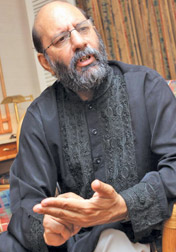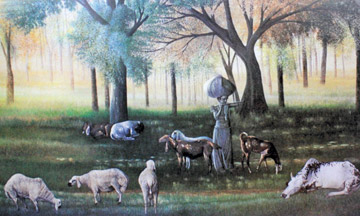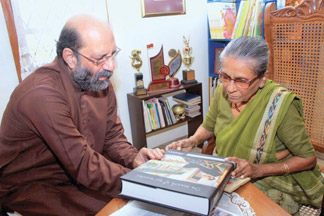|

Engineering miracles
Ruwini JAYAWARDANA
Although an artist his true passion lies in humanity and welfare. He
has emerged as a peaceful crusader for the oppressed, disabled, mentally
handicapped, impoverished and generally for whosoever needs him.
“Pakistan does not require great actors but great people. If I create
paintings just for the sake of those people who appreciate art, what
about those people who are suffering on roads? I feel guilty that I was
creating masterpieces and my countrymen were living in misery,” says
Jimmy Engineer.
 |
|
Jimmy
Enginner. Pictures by Nissanka Wijeratne |
 Born to a Parsi family in Loralai, Balochistan, Engineer was educated
in Lahore before settling in Karachi. He has over 2000 paintings, 1000
calligraphies and a number of stamps to his name. He also works on a
vast variety of themes: historical, philosophical, landscapes, moods,
seascapes, architectural and cultural paintings. They also included
abstract art, figures work, calligraphic paintings addressing the theme
of war and terrorism. Born to a Parsi family in Loralai, Balochistan, Engineer was educated
in Lahore before settling in Karachi. He has over 2000 paintings, 1000
calligraphies and a number of stamps to his name. He also works on a
vast variety of themes: historical, philosophical, landscapes, moods,
seascapes, architectural and cultural paintings. They also included
abstract art, figures work, calligraphic paintings addressing the theme
of war and terrorism.
Some of his most famous work comprises a painting depicting Partition
which is on display at the National
Art Gallery in Islamabad and his artistic interpretation of great
thinker and poet Allama Muhammad Iqbal’s epic poem ‘Javed Nama'.
Around 20, 000 prints of his work are in private collections around
the world including China, India, Pakistan, Russia, UK and US.
‘In Search of My Master’, a 612-page epic volume illustrating the
artist's work carried out in the during the last four decades was
launched recently.
Q: Most artists stick to one or two subjects for their
paintings while you work on a variety of themes.
A: I was born into one of the most remote areas of Pakistan.
As I grew up I became a student of nature. You are dealing with the
perfect master then because nature is perfect while we are imperfect. I
thought that if I just work on one theme I'll not learn enough to have
the liberty of painting diverse themes and styles. However I strive to
achieve a level of excellence in whatever I paint.

 |
|
Jimmy’s
paintings |
 |
I will always remain a pupil of nature. I am still learning after 40
years of art and I hope to keep learning. I do not want to stick to one
theme and learn nothing. I want to know how different themes offer
diverse challenges to an artist. When the process of learning stops the
end comes.
Q: Art generally has a healing power on its viewers. Despite
taking on themes like war and tragedy, did the work have a therapeutic
quality on you as its artist?
A: Basically art is a therapy for all artists but it depends
on the individual. Some artists are born artists, some work hard to
excel in their field while others have a natural artistic flair.
I painted my dreams because of my connection to nature during
childhood. I heard voices telling me what to do and they used to show me
a lot of things regarding the future. I was connected with some master
but later, as I grew up, I only wanted to help people. I wanted to
change their life through art. I followed my inner voices and painted
all the images that I felt I should paint to educate the younger
generation and generations to come.
Q: Was it difficult to paint the ‘Javed Nama’ especially
because you had to mould your painting through Iqbal’s verses?
A: It was the most difficult work I have done in my life. When
the poet was alive he wrote in his letter that he would like some artist
to create a visual display of the philosophy in the poem. There were two
or three great painters from other countries who tried their hand at the
deed. They were only able to paint one scene not the whole thing.
I went through his letter and discovered that he had written that the
man who paints ‘Javed Nama’ will have a great name in the world. He had
also penned that only the artist with the ‘knowledge of the higher
intellect’ will be able to do the work.
The poet’s son invited me to take on the project in 1981 saying that
since I paint my partition series from my dreams, I would be able to
accomplish the task. He gave me a 10 feet x 15 feet wall. I said that
I’ll start from the left side of the bottom and finish it on the right
side on the top.
I stayed one year and completed the whole poem. A lot of people were
fascinated on how poetry can be converted on a wall. It starts exactly
from the left side and finishes exactly on the right side.
 |
|
Jimmy hands
over a copy of his book to Sybil Wettasinghe |
You can make a painting but there are times when it can be out of
balance. Nothing was out of balance in this case. The interesting thing
was when the son came to ask me when I would finish my work I would tell
him that his father too comes to me asking that question.
Q: Do you need to have some knowledge of architecture to paint
the images of buildings that you have painted in your work?
A: I am not an architect and I am only by name Engineer. I
have no clue about architecture. What fascinates me is the different
structures. I have got a special inbuilt mechanism which tells me that
my work is balanced or not. It is almost like an inbuilt computer.
People are amazed how everything is in place in these drawings.
Nothing juts out from here and there. Seeing everything in total balance
is a quality which derives from childhood.
Q: How do your social service campaigns affect your art and
vice versa?
A: There are about three branches in my social service
activities. One is the suffering of people. I follow the Buddha’s way of
life. If you want to help someone take his or her suffering on yourself.
That was my philosophy from my younger days.
I believe that we should go to the sufferers, not that the sufferers
should come to us.
I also conduct awareness programmes. I think I must have organised
more walks than any other human being ever for different causes. My
longest walk was when I walked for one year, covering about 4700
kilometres across Pakistan visiting all the towns, villages and bazaars.
The other form of social service programme which I conduct is for
orphans and special children. I want to change their lives. If the rich
parents’ children can come to a luxury hotel, then even the poor
children can come to the same place.
As a human rights activist I work in jails, entertain and help
prisoners. I am a vocal opponent for violence and warfare. You need to
be aggressive as a human right activist because you have to deal with
aggressive people while your role as a peace maker demands you not to be
aggressive. It is not easy to live this kind of life as one person but I
manage.
 |
|
Fun and
food programme held in Sri Lanka in 2004 |
The Buddha gave away all his materialistic items and exchanged it for
higher enlightenment. Hoteliers promised to continue with the programmes
I came and did in 2004 but I know people have a very short memory and
they are too busy with their own lifestyle to think of these matters.
But if they had continued these programmes it would have become a great
movement by now. I am sure I will come to Sri Lanka again for another
programme on behalf of the special children. I want to arrange it with
senior journalist Malini Govinnage whom I met during my previous visit.
Q: You have dubbed the process of overcoming your kidney
failure as the ‘first miracle’ in your life. What are the other
‘miracles’ you have encountered?
A: You might be creating some kind of miracle by merely
sitting on your sofa or walking on the road. You never know what will
happen in life.
When I was in Sri Lanka in 2004 it had not rained properly for
several years. I was speaking to Malini during that time and told her
that before I leave, it would rain. Three or four days before my flight,
there was a downpour.
Q: Who is your ‘master’?
A: I think we will always remain imperfect. If you are
perfect, you will be the creator. I may be having a lot of negative and
imperfect aspects but the important thing is I am trying to follow the
perfect path.
The title of the book was given by me. It is written by noted art
critic Marjorie Husain. They wanted to take out all my social work and
some of my art from the book because they said that nobody will be able
to carry the book! It would have been 1200 or 1300 pages instead of 612. |



